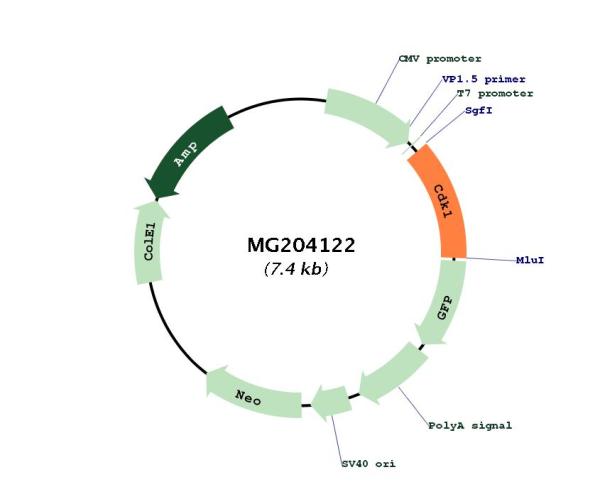Cdk1 (NM_007659) Mouse Tagged ORF Clone
CAT#: MG204122
- TrueORF®
Cdk1 (tGFP-tagged) - Mouse cell division cycle 2 homolog A (S. pombe) (Cdc2a)
ORF Plasmid: DDK
Lentiviral Particles: DDK w/ Puro mGFP w/ Puro
AAV Particle: DDK
"NM_007659" in other vectors (4)
Specifications
| Product Data | |
| Type | Mouse Tagged ORF Clone |
| Tag | TurboGFP |
| Symbol | Cdk1 |
| Synonyms | Cdc2; Cdc2a; p34 |
| Vector | pCMV6-AC-GFP |
| E. coli Selection | Ampicillin (100 ug/mL) |
| Mammalian Cell Selection | Neomycin |
| Sequence Data |
>MG204122 representing NM_007659
Red=Cloning site Blue=ORF Green=Tags(s) TTTTGTAATACGACTCACTATAGGGCGGCCGGGAATTCGTCGACTGGATCCGGTACCGAGGAGATCTGCC GCCGCGATCGCC ATGGAAGACTATATCAAAATAGAGAAAATTGGAGAAGGTACTTACGGTGTGGTGTATAAGGGTAGACACA GAGTCACTGGCCAGATAGTGGCCATGAAGAAGATCAGACTTGAAAGCGAGGAAGAAGGAGTGCCCAGTAC TGCAATTCGGGAAATCTCTCTATTAAAAGAACTTCGACATCCAAATATAGTCAGCCTGCAGGATGTGCTC ATGCAGGACTCCAGGCTGTATCTCATCTTTGAGTTCCTGTCCATGGACCTCAAGAAGTACCTGGACTCCA TCCCTCCTGGGCAGTTCATGGATTCTTCACTCGTTAAGAGTTACTTACACCAAATCCTCCAGGGAATTGT GTTTTGCCACTCCCGGCGAGTTCTTCACAGAGACTTGAAACCTCAAAATCTATTGATTGATGACAAAGGA ACAATCAAACTGGCTGATTTCGGCCTTGCCAGAGCGTTTGGAATACCGATACGAGTGTACACACACGAGG TAGTGACGCTGTGGTACCGATCTCCAGAAGTGTTGCTGGGCTCGGCTCGTTACTCCACTCCGGTTGACAT CTGGAGTATAGGGACCATATTTGCAGAACTGGCCACCAAGAAGCCGCTTTTCCACGGCGACTCAGAGATT GACCAGCTCTTCAGGATCTTCAGAGCTCTGGGCACTCCTAACAACGAAGTGTGGCCAGAAGTCGAGTCCC TGCAGGACTACAAGAACACCTTTCCCAAGTGGAAGCCGGGGAGCCTCGCATCCCACGTCAAGAACCTGGA CGAGAACGGCTTGGATTTGCTCTCAAAAATGCTAGTCTATGATCCTGCCAAACGAATCTCTGGCAAAATG GCCCTGAAGCACCCGTACTTTGATGACTTGGACAATCAGATTAAGAAGATG ACGCGTACGCGGCCGCTCGAG - GFP Tag - GTTTAA >MG204122 representing NM_007659
Red=Cloning site Green=Tags(s) MEDYIKIEKIGEGTYGVVYKGRHRVTGQIVAMKKIRLESEEEGVPSTAIREISLLKELRHPNIVSLQDVL MQDSRLYLIFEFLSMDLKKYLDSIPPGQFMDSSLVKSYLHQILQGIVFCHSRRVLHRDLKPQNLLIDDKG TIKLADFGLARAFGIPIRVYTHEVVTLWYRSPEVLLGSARYSTPVDIWSIGTIFAELATKKPLFHGDSEI DQLFRIFRALGTPNNEVWPEVESLQDYKNTFPKWKPGSLASHVKNLDENGLDLLSKMLVYDPAKRISGKM ALKHPYFDDLDNQIKKM TRTRPLE - GFP Tag - V |
| Restriction Sites |
SgfI-MluI
Cloning Scheme for this gene
Plasmid Map

|
| ACCN | NM_007659 |
| ORF Size | 891 bp |
| OTI Disclaimer | The molecular sequence of this clone aligns with the gene accession number as a point of reference only. However, individual transcript sequences of the same gene can differ through naturally occurring variations (e.g. polymorphisms), each with its own valid existence. This clone is substantially in agreement with the reference, but a complete review of all prevailing variants is recommended prior to use. More info |
| OTI Annotation | This clone was engineered to express the complete ORF with an expression tag. Expression varies depending on the nature of the gene. |
| Product Components | The ORF clone is ion-exchange column purified and shipped in a 2D barcoded Matrix tube containing 10ug of transfection-ready, dried plasmid DNA (reconstitute with 100 ul of water). |
| Reconstitution | 1. Centrifuge at 5,000xg for 5min. 2. Carefully open the tube and add 100ul of sterile water to dissolve the DNA. 3. Close the tube and incubate for 10 minutes at room temperature. 4. Briefly vortex the tube and then do a quick spin (less than 5000xg) to concentrate the liquid at the bottom. 5. Store the suspended plasmid at -20°C. The DNA is stable for at least one year from date of shipping when stored at -20°C. |
| Reference Data | |
| RefSeq | NM_007659.4 |
| RefSeq Size | 2862 bp |
| RefSeq ORF | 894 bp |
| Locus ID | 12534 |
| UniProt ID | P11440 |
| Cytogenetics | 10 36.07 cM |
| Gene Summary | Plays a key role in the control of the eukaryotic cell cycle by modulating the centrosome cycle as well as mitotic onset; promotes G2-M transition, and regulates G1 progress and G1-S transition via association with multiple interphase cyclins. Required in higher cells for entry into S-phase and mitosis. Phosphorylates PARVA/actopaxin, APC, AMPH, APC, BARD1, Bcl-xL/BCL2L1, BRCA2, CALD1, CASP8, CDC7, CDC20, CDC25A, CDC25C, CC2D1A, CENPA, CSNK2 proteins/CKII, FZR1/CDH1, CDK7, CEBPB, CHAMP1, DMD/dystrophin, EEF1 proteins/EF-1, EZH2, KIF11/EG5, EGFR, FANCG, FOS, GFAP, GOLGA2/GM130, GRASP1, UBE2A/hHR6A, HIST1H1 proteins/histone H1, HMGA1, HIVEP3/KRC, LMNA, LMNB, LMNC, LBR, LATS1, MAP1B, MAP4, MARCKS, MCM2, MCM4, MKLP1, MYB, NEFH, NFIC, NPC/nuclear pore complex, PITPNM1/NIR2, NPM1, NCL, NUCKS1, NPM1/numatrin, ORC1, PRKAR2A, EEF1E1/p18, EIF3F/p47, p53/TP53, NONO/p54NRB, PAPOLA, PLEC/plectin, RB1, UL40/R2, RAB4A, RAP1GAP, RCC1, RPS6KB1/S6K1, KHDRBS1/SAM68, ESPL1, SKI, BIRC5/survivin, STIP1, TEX14, beta-tubulins, MAPT/TAU, NEDD1, VIM/vimentin, TK1, FOXO1, RUNX1/AML1, SAMHD1, SIRT2 and RUNX2. CDK1/CDC2-cyclin-B controls pronuclear union in interphase fertilized eggs. Essential for early stages of embryonic development. During G2 and early mitosis, CDC25A/B/C-mediated dephosphorylation activates CDK1/cyclin complexes which phosphorylate several substrates that trigger at least centrosome separation, Golgi dynamics, nuclear envelope breakdown and chromosome condensation. Once chromosomes are condensed and aligned at the metaphase plate, CDK1 activity is switched off by WEE1- and PKMYT1-mediated phosphorylation to allow sister chromatid separation, chromosome decondensation, reformation of the nuclear envelope and cytokinesis. Inactivated by PKR/EIF2AK2- and WEE1-mediated phosphorylation upon DNA damage to stop cell cycle and genome replication at the G2 checkpoint thus facilitating DNA repair. Reactivated after successful DNA repair through WIP1-dependent signaling leading to CDC25A/B/C-mediated dephosphorylation and restoring cell cycle progression. In proliferating cells, CDK1-mediated FOXO1 phosphorylation at the G2-M phase represses FOXO1 interaction with 14-3-3 proteins and thereby promotes FOXO1 nuclear accumulation and transcription factor activity, leading to cell death of postmitotic neurons. The phosphorylation of beta-tubulins regulates microtubule dynamics during mitosis. NEDD1 phosphorylation promotes PLK1-mediated NEDD1 phosphorylation and subsequent targeting of the gamma-tubulin ring complex (gTuRC) to the centrosome, an important step for spindle formation. In addition, CC2D1A phosphorylation regulates CC2D1A spindle pole localization and association with SCC1/RAD21 and centriole cohesion during mitosis. The phosphorylation of Bcl-xL/BCL2L1 after prolongated G2 arrest upon DNA damage triggers apoptosis. In contrast, CASP8 phosphorylation during mitosis prevents its activation by proteolysis and subsequent apoptosis. This phosphorylation occurs in cancer cell lines, as well as in primary breast tissues and lymphocytes. EZH2 phosphorylation promotes H3K27me3 maintenance and epigenetic gene silencing. CALD1 phosphorylation promotes Schwann cell migration during peripheral nerve regeneration. CDK1-cyclin-B complex phosphorylates NCKAP5L and mediates its dissociation from centrosomes during mitosis. Regulates the amplitude of the cyclic expression of the core clock gene ARNTL/BMAL1 by phosphorylating its transcriptional repressor NR1D1, and this phosphorylation is necessary for SCF(FBXW7)-mediated ubiquitination and proteasomal degradation of NR1D1 (By similarity).[UniProtKB/Swiss-Prot Function] |
Documents
| Product Manuals |
| FAQs |
| SDS |
Resources
Other Versions
| SKU | Description | Size | Price |
|---|---|---|---|
| MC202142 | Cdk1 (untagged) - Mouse cyclin-dependent kinase 1 (Cdk1), (10ug) |
USD 300.00 |
|
| MR204122 | Cdk1 (Myc-DDK-tagged) - Mouse cyclin-dependent kinase 1 (Cdk1) |
USD 300.00 |
|
| MR204122L3 | Lenti ORF clone of Cdk1 (Myc-DDK-tagged) - Mouse cyclin-dependent kinase 1 (Cdk1) |
USD 600.00 |
|
| MR204122L4 | Lenti ORF clone of Cdk1 (mGFP-tagged) - Mouse cyclin-dependent kinase 1 (Cdk1) |
USD 600.00 |
{0} Product Review(s)
Be the first one to submit a review






























































































































































































































































 Germany
Germany
 Japan
Japan
 United Kingdom
United Kingdom
 China
China

